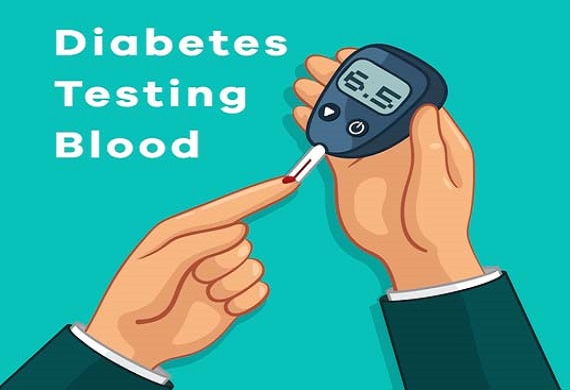
Manage Diabetes by Learning All About Blood Sugar Levels
By: Rupali, Content Writer | Tuesday, 15 November 2022
For a person having diabetes the constant challenge that you face is to keep the levels of blood sugar under control. Keeping yourself at a normal blood glucose level is the key to your diabetes management. Controlled diabetes mitigates the risk of any further complications arising from diabetes.
But diabetes is not the same for every individual. Our modern lives come with challenges which are often a cause of diabetes. Hence the targets for each person to keep diabetes under control also vary. In all cases, an opinion from an expert is required to be sought and instructions are to be followed to avoid complications.
You may have heard people saying blood sugar normal range, but what does it mean? Let us know more about it in this article.
What is the normal blood sugar range?
For a person having diabetes understanding what should be the normal blood glucose level is very critical. In diabetes, the body is incapable of producing insulin in adequate quantities. As a result, this level of sugar in the bloodstream is always above the normal range. Thus, the process of managing diabetes is essentially maintaining sugar levels in the blood at a normal level.
Persistence of the condition of sugar levels beyond permissible limits may lead to many complications. In situations of uncontrolled diabetes, you may eventually land up with heart ailments, kidney failures and loss of vision. This is why medical experts advise carrying out periodic blood tests to ascertain your blood sugar levels.
Whether or not you have a condition of persistent high blood sugar a normal range of 90-100 mg/dL is considered to be normal. It is crucial to maintain the blood sugar level within these permissible limits at all times. For a person having diabetes, a blood sugar level of up to 140 mg/dL is considered to be acceptable.
If you have diabetes, you may find it hard to keep your blood sugar levels under control. A consistently high average reading of blood sugar levels detected through HbA1c tests is a danger signal. The same needs to be arrested for avoiding any further complications which may have an irreversible impact on your health conditions.
What is the ideal blood sugar level for a person not having diabetes?
For a better understanding of a normal blood glucose level, you need to look at readings under the below situations:
1. Fasting Blood Sugar:
This is the reading of the blood sugar taken before breakfast after overnight fasting. The ideal blood sugar level is 80-100 mg/dL.
2. Postprandial (after meals):
Normal sugar level after food should be 150 mg/dL.
3. Random Tests:
This is a crucial test as this shows the blood sugar level at any point of time in the day. For a person not having diabetes a normal blood glucose level is considered to be between 90 and 130 mg/dL.
What is the ideal blood sugar level for a person having diabetes?
For a person who already has high blood sugar, the normal range varies from a non-diabetic person. A blood sugar level of up to 140 mg/dL is considered normal for a person having diabetes. Let us have look at the same segregated in specific age brackets:
What is the ideal blood sugar level for a non-diabetic person?
1. Age Less Than 6 years:
The chart is given below shows the blood sugar range in children below six years:
|
Time of Measurement |
Normal Range |
|---|---|
|
After Overnight Fasting and Before Breakfast |
80 to 180 mg/dL |
|
Before Meal |
100 to 180 mg/dL |
|
Post Prandial (Meal) |
180 mg/dL |
|
At Bedtime |
110 to 200 mg/dL |
2. Adolescents (Six to Twelve Years):
The range of blood sugar considered to be normal in adolescents is as under:
|
Time of Measurement |
Normal Range |
|---|---|
|
After Overnight Fasting and Before Breakfast |
80 to 180 mg/dL |
|
Before Meal |
100 to 180 mg/dL |
|
Postprandial (Meal) |
180 mg/dL |
|
At Bedtime |
110 to 200 mg/dL |
3. Teenagers (Thirteen to Nineteen years):
Managing your blood sugar is comparatively easy with teenagers as they are expected to be more mature than children below twelve years. Under normal circumstances, the life of a teenager is more active than small children which acts as a mitigating factor to keep blood sugar under check. The normal ranges for a teenager are as under:
|
Time of Measurement |
Normal Range |
|---|---|
|
After Overnight Fasting and Before Breakfast |
70 to 150 mg/dL |
|
Before Meal |
90 to 130 mg/dL |
|
Postprandial (Meal) |
140 mg/dL |
|
At Bedtime |
90 to 150 mg/dL |
4. Adults (age 20 years and above):
People falling in this age category are mature to understand the perils of having high blood sugar levels. They are expected to lead an active lifestyle and have a balanced and sugar free diet to keep blood glucose at normal levels. The accepted range of blood sugar is given hereunder:
|
Time of Measurement |
Normal Range |
|---|---|
|
After Overnight Fasting and Before Breakfast |
70 to 150 mg/dL |
|
Before Meal |
90 to 130 mg/dL |
|
Post Prandial (Meal) |
140 mg/dL |
|
At Bedtime |
90 to 150 mg/dL |
Symptoms of high blood sugar:
The condition where the level of blood sugar is above the normal level is called hyperglycemia. Some of the common symptoms of hyperglycemia include:
- Feeling of fatigue
- Constant and frequent headaches
- Dryness of the throat
- Abnormal hunger
- Recurrent feeling to urinate
- Feeling tired without any apparent reason
These are the signals of diabetes. Once some of these symptoms are felt you need to consult a medical expert and get yourself examined without losing time.
What is hypoglycemia?
There may be a condition where the level of glucose in your blood goes down below the normal limit. This is called hypoglycemia. For a person having diabetes hypoglycemia is a dangerous condition to be in. The signs of having low blood sugar are as under:
- Gasping for breath
- Cold sweats
- Shaking hands
- Trembling of feet and hands
- Feeling dizzy
- Blurry vision
For a person having diabetes consultation with medical experts is of critical importance. You need to be in touch with the doctor and get yourself examined regularly to ensure that blood sugar levels are within the normal range.
Summing Up:
Managing blood sugar is the biggest challenge faced by a person with diabetes. Frequent spikes or extremely low blood sugar levels are not an ideal condition. Regular medical checkups and blood tests need to be carried out to keep diabetes under control. Though blood sugar levels vary with age and the “normal” levels are different across age groups one needs to be vigilant to avoid any further complications arising out of diabetes.
Most Viewed
- 1 Women's Health Startup HerMD Closing Doors Amid Industry Challenges
- 2 5 Famous Women in Indian Armed Forces
- 3 Saudi Women No longer Require Male Permission for Clothing Choices, says Prince MbS
- 4 Kolkata Medtech Startup Innovodigm Raises Rs 5.5 Crore Seed Funding Led by IAN Group
- 5 Yamunanagar's Kashish Kalra Honoured after Securing 111th Rank in UPSC Civil Services Exam
- 6 Madurai Appoints Its First Woman Corporation Head
- 7 IAS Vijayalakshmi Bidari Appointed as the new Nagpur Divisional Commissioner
- 8 American Entrepreneur Lucy Guo Overtakes T Swift to become Youngest Female Billionaire
- 9 ICC Women's World Cup 2025 Trophy Showcased at Indore's Holkar Stadium
- 10 Aparna Saxena's Beauty Venture AntiNorm Launches in India
- 11 Vidya Nataraj Co-Founded BlueStone Jewellery & Lifestyle files IPO
- 12 5 Women Freedom Fighters of India
- 13 Dr. G Krishnapriya appointed as CEO for Trichy
- 14 M3M & Sirona Partner to Introduce Menstrual Hygiene Vending Machines in 15 Locations
- 15 Punjab Govt launches SHE Cohort 3.0 Supporting Tech-led Women Startups
- 16 Indian origin Lawyer, Sweena Pannu appointed as the US New Superior Court Judge
- 17 The Aurora Tech Award recognizes 4 Indian Women-led Startups
- 18 Kerala's Republic Day parade featured an all-female tableau
- 19 Manisha Kabbur Becomes Karnataka's First Woman International Karate Coach
- 20 Director K. S. Ravikumar's Daughter Maalica Ravikumar Launches Life Coaching Company 'Evergrowth Academy' for Women
- 21 Leezu's Raises Pre-Seed Funding to Accelerate Growth in Sexual Wellness Industry
- 22 Sattu: Super-easy summer drink for PCOS gut healing
- 23 Swathi Nelabhatla creates Sitha App, India's First Women-Exclusive Gig Platform
- 24 7 Timeless Female Kathak Dancers & their Iconic Legacies
- 25 Meet 7 Iconic Women Architects of Modern India & their Most Impactful Work
- 26 This Woman-led Insuretech Startup is Helping Bridge the Education Financing Gap in India
- 27 Women Leaders Share Lessons Learnt from India Women's WC Win
- 28 5 Enterprising Women Founders Powering Singapore's Tech & Innovation Landscape
- 29 4 Women. 4 Stories. One Vision for Smarter, Stronger Healthcare
- 30 Global Gender Gap Narrows to 68.8%, But Full Equality 123 Years Away: WEF Report 2025
- 31 Changemakers: 7 Women Entrepreneurs Taking the Make in India Movement Forward
- 32 Meet Lucy Guo, The Youngest Self-Made Female Billionaire Disrupting Tech
- 33 How Women are Driving India's Festive Online Shopping Surge






